by Amy Mullins, PhD, RDN | Sep 25, 2016
 A “sweet tooth” is something we are probably all guilty of having, to some degree. Eating the occasional cookie or slice of pie isn’t a crime and can have a place in the American diet, if consumed in moderation. Unfortunately, in our society there are enormous opportunities for sugary food, even in places where you’d least expect.
A “sweet tooth” is something we are probably all guilty of having, to some degree. Eating the occasional cookie or slice of pie isn’t a crime and can have a place in the American diet, if consumed in moderation. Unfortunately, in our society there are enormous opportunities for sugary food, even in places where you’d least expect.
Sugar in American food isn’t as obvious as it once was and seems to be lurking everywhere. Then there is the concept of “added sugars”, which may add to the confusion. Added sugar is exactly what it seems… additional sugar but with no nutritional benefit other than extra calories. The new food label has addressed this by showing grams of added sugars and also the % Daily Value based on the serving size. It’s important to check out the ingredient list on packaged products as well. Sugar has numerous forms and names, including brown sugar, raw sugar, corn syrup, lactose, dextrose, fructose, glucose, sucrose, high fructose corn syrup, honey, invert sugar, malt syrup, maltose, and molasses. The ingredients are listed in order of descending weight, so if sugar is a main ingredient in the product you will see it near the beginning of the ingredient list.
Is sugar bad?
Naturally occurring sugars, such as those in fruit or milk, are not considered added sugars. Natural sugars (carbohydrates) are part of many healthy unprocessed fruits, vegetables, and milk. These foods are good and are part of an overall healthy diet. The problem lies in the “added sugar” we often see in processed foods, even bread and yogurt can contain a large amount of additional sugar. We all know sugar has calories and extra calories can lead to putting on extra pounds. But, it’s not just our waistlines that may pay the price. A 2014 study published by the Journal of the American Medical Association-Internal Medicine found a “significant relationship between added sugar consumption and increased risk for CVD mortality”.
It seems that sugar may be causing more problems than initially believed, and until recently there haven’t been any official guidelines on how much sugar is acceptable. When the new Dietary Guidelines for Americans were released, this was a major factor to be addressed. A “Key Recommendation” calls for less than 10% of calories per day from added sugars. The American Heart Association goes even further with a recommendation of no more than 100 calories per day for women (about 6 teaspoons or 24 grams), and 150 calories per day (about 9 teaspoons or 36 grams) for men.
Currently, on average, added sugars account for almost 270 calories per day (more than 13%) and are particularly highest among children, adolescents, and young adults. Not surprisingly, beverages (soft drinks, fruit drinks, sweetened coffee and tea, energy drinks, alcoholic beverages, flavored water) account for 47% of all added sugars consumed in the U.S. (2015-2020 Dietary Guidelines for Americans).
What can we do?
Cutting down on sugary beverages such as soda, sports drinks, fruit juices, and syrupy coffee drinks is the first step in reducing our consumption of sugar. Reading labels and ingredient lists can help you identify how much carbohydrate and added sugar are in a product. Choose beverages with no-added sugars such as water, and limit or decrease portion sizes of grain-based and dairy desserts, sweet snacks, cakes, and candy. Choose unsweetened canned fruits, applesauce, and yogurt with no sugar added (2015-2020 Dietary Guidelines for Americans). The American Heart Association offers some additional Tips for Cutting Down on Sugar and ways to Sip Smarter.
With some label reading and determination we can change our consumption of sugar, reduce our waistlines, and reduce the risk of developing obesity-related chronic diseases.
Resources:
2015-2020 Dietary Guidelines for Americans
Added Sugars Add to Your Risk of Dying from Heart Disease, American Heart Association
Changes to the Nutrition Facts Label, FDA U.S Food and Drug Administration
Added sugar intake and cardiovascular diseases mortality among US adults, JAMA Intern Med. 2014 Apr;174(4):516-24.
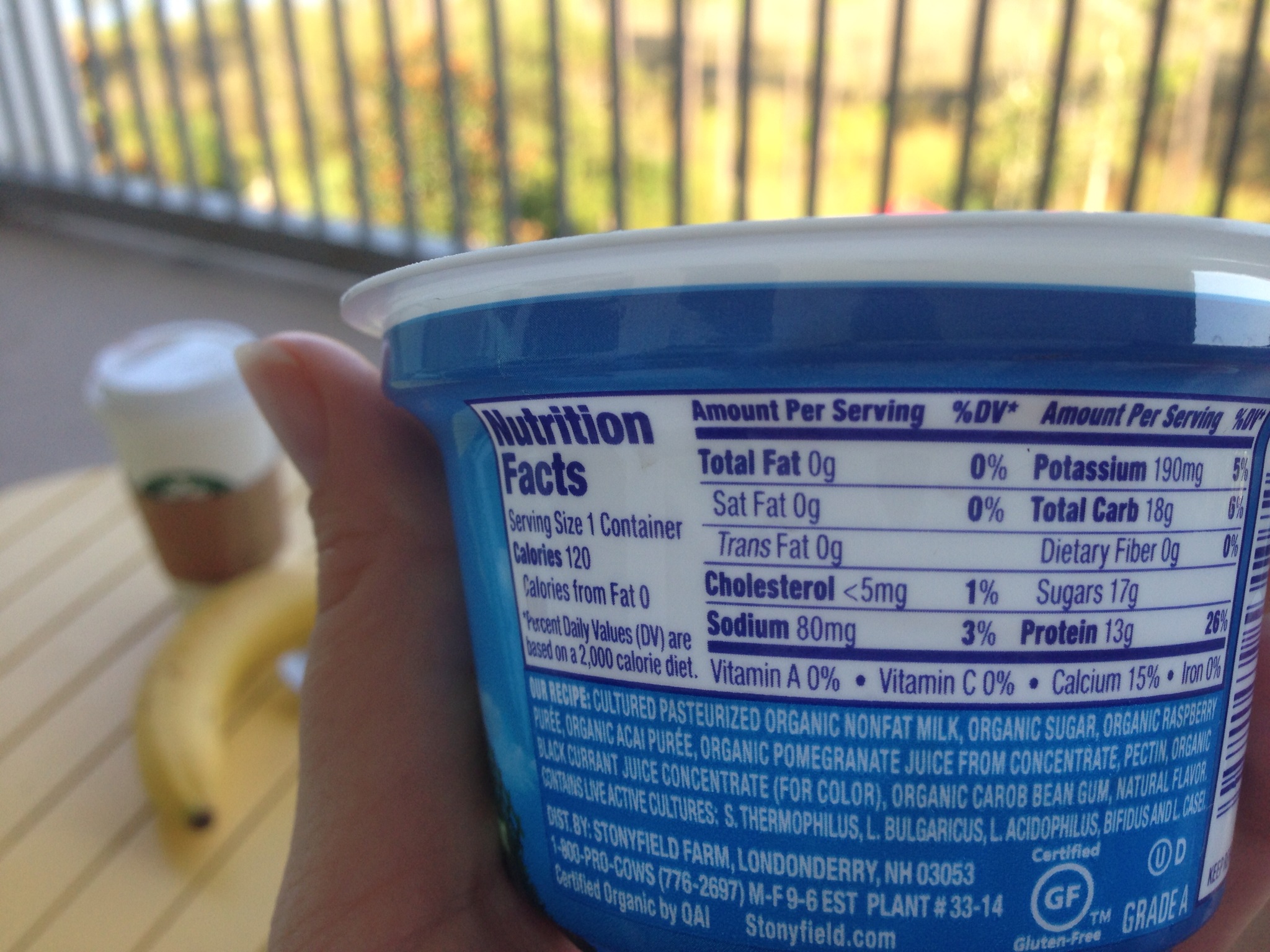
by Amy Mullins, PhD, RDN | Jul 29, 2016
The Nutrition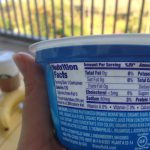 Facts label, seen on packaged bags, boxes, cans, etc., is the consumer information gateway to making healthy choices for ourselves and our families. But let’s face it, for many Americans, interpreting the Nutrition Facts label can be downright confusing, at times, essentially clouding our decision-making abilities.
Facts label, seen on packaged bags, boxes, cans, etc., is the consumer information gateway to making healthy choices for ourselves and our families. But let’s face it, for many Americans, interpreting the Nutrition Facts label can be downright confusing, at times, essentially clouding our decision-making abilities.
Making informed decisions about what you eat every day is an important step in maintaining good nutrition, reducing your risk for heart disease, and keeping your weight in a healthy range. After more than 20 years, the FDA has finalized an improved version of the old label to be in full effect nationwide by mid-2018. First Lady Michelle Obama states, “This is going to make a real difference in providing families across the country the information they need to make healthy choices.”
Key Changes to Look For on the New Label: 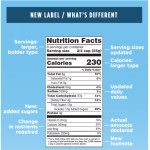
- Added Sugars – One of the more important changes is based on data that shows the difficulty in meeting nutrient needs while staying within calorie limits if you consume more than 10 percent of your total daily calories from added sugar.
- Specific Vitamins & Minerals – Vitamin D and potassium will be required on the label. Calcium and iron will continue to be required. Vitamins A and C will no longer be required but can be included on a voluntary basis.
- Daily Values (%) – Updates on sodium, dietary fiber, and Vitamin D.
- Serving Sizes – Now reflect actual common amounts consumed, not recommended amounts. For example, a serving size for soda previously was 8oz. but is now 12oz.
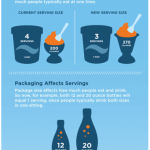 Package Size – Calories and other nutrients will be required to be labeled as one serving because people typically consume it in one sitting.
Package Size – Calories and other nutrients will be required to be labeled as one serving because people typically consume it in one sitting.
- New Format – Highlighting “Calories,” “Servings per container,” and the “Serving size” declaration by increasing the type size and placing the number of calories and the “Serving size” declaration in bold type as well as changing the footnote to better explain the percent Daily Value.
The new label regulations apply to packaged foods except certain meat, poultry, and processed egg products, which are regulated by the U.S. Department of Agriculture’s Food Safety and Inspection Service. To learn more about these important changes, visit the Food and Drug Administration website and read Changes to the Nutrition Facts Label.

by Amy Mullins, PhD, RDN | Jun 29, 2016
I t seems that most Americans start their mornings off with a mug of hot coffee, iced coffee, or any number of fancy variations. For many, it’s the key to starting your day off right. Ever notice what happens when you don’t get your coffee in the morning? Let’s just say, it can be enough to change your mood for the worse. So, what is it about coffee that is so appealing to people worldwide? You guessed it… caffeine.
t seems that most Americans start their mornings off with a mug of hot coffee, iced coffee, or any number of fancy variations. For many, it’s the key to starting your day off right. Ever notice what happens when you don’t get your coffee in the morning? Let’s just say, it can be enough to change your mood for the worse. So, what is it about coffee that is so appealing to people worldwide? You guessed it… caffeine.
Caffeine acts in the body as a short-acting stimulant and is found naturally in certain plants, seeds, and the fruits of more than 60 plants such as tea, coffee, cocoa beans, and kola nuts. Caffeine also is widely added to a growing number and variety of beverages, edibles, and medications.
There have been numerous studies on caffeine and how it affects the body – some good, some bad, and some inconclusive. The National Institutes of Health (NIH) states that for most people, the amount of caffeine in two to four cups of coffee a day is not harmful. Some people may be more sensitive to the effects of caffeine and may even experience harmful effects (including pregnant and nursing women, children and teenagers) and should limit or avoid its use.
It is generally recognized that up to 400 mg of caffeine per day is considered safe for healthy adults; however, too much caffeine (500-600 mg/day) can cause problems such as:
- Make you jittery, shaky, nervous, restless, and irritable
- Make it hard to fall asleep or stay asleep
- Headaches or dizziness
- Make your heart beat faster or cause abnormal heart rhythms
- Dehydration
- Upset stomach
- Make you dependent on it so you need to take more of it. If you stop using caffeine, you could get withdrawal symptoms.
- Interfere with the metabolism of certain medications.
How much caffeine is in your favorite coffee, tea, soft drink, snack food, chocolate, or medication? A regular home-brewed cup of coffee (8 oz.) typically has about 100mg of caffeine. But, different brands and products contain widely varying amounts. For instance, a grande cup of Starbucks coffee has 330 mg compared to McDonald’s brewed coffee with only 133 mg of caffeine, for approximately the same size.
Want a real “eye-opener”? Check out this extensive list of the Caffeine Content of Food & Drugs by the Center for Science in the Public Interest.
The bottom line is that it’s okay to drink your cup of Joe in the morning and/or afternoon, but just remember moderation is the key!
References:
https://www.nlm.nih.gov/medlineplus/
http://www.eatright.org/
http://www.cspinet.org/
by Amy Mullins, PhD, RDN | May 30, 2016
It’s hard to believe that summer is almost here and the kids are out of school! Often times, when kids (and parents too) get away from their normal routine, poor eating and snacking habits creep in. It’s important for kids (and parents) to have a variety of go-to snacks that are tasty, healthy, and easy to prepare!
Put some thought into which snacks make the best choices, and get input from the kids. Children and teenagers are more likely to eat what you buy (and be excited about it!), if they help in the process.
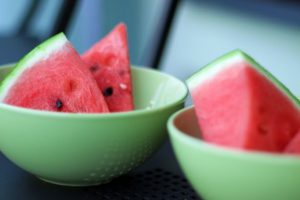 1.) PLAN: Sit down together and make a list of snack-type foods they might like, and can easily prepare themselves.
1.) PLAN: Sit down together and make a list of snack-type foods they might like, and can easily prepare themselves.
2.) LIST: Make a list of the foods you’ll need to pick up at the grocery store.
3.) SHOP: Take the kids with you shopping… let them help fill the cart with the foods you’ve agreed on.
4.) PREPARE: Allow the kids to help wash, cut, portion, and prepare snacks. This will give them more confidence in the kitchen… now and as a future adult.
Stumped on where to get started? Your best bet is to stay away from processed, pre-packaged snack foods, and sugary drinks. These are typically high in unhealthy fats, oils, and sugar, and lack the vitamins, minerals, and fiber fresh and frozen whole foods have.
Try these super easy and healthy snacks:
- Layer vanilla yogurt and mandarin oranges or blueberries in a tall glass. Top with a sprinkle of granola to make a “parfait”.
- Put cubes of low-fat cheese and grapes on pretzel sticks to make “snack-kabobs”.
- Top a banana with low-fat vanilla and strawberry frozen yogurt and sprinkle with your favorite whole-grain cereal for a healthy “banana-split”.
- Use whole grain (flour or corn) tortillas and top with tomato sauce, cut veggies and shredded cheese. Eat it flat (like a pizza) or roll it up (like a wrap).
Keep your children, and yourself, on track this summer by remembering these main messages from ChooseMyPlate and The Dietary Guidelines:
- Make half your plate fruits and vegetables.
- Focus on whole fruits.
- Vary your veggies.
- Make half your grains whole grains.
- Move to low-fat and fat-free milk or yogurt.
- Vary your protein routine.
- Drink and eat less sodium, saturated fat, and added sugars.
Everything you eat and drink over time matters. The right mix can help you be healthier now and in the future. Start with small changes to make healthier choices you can enjoy. Find your healthy eating style and maintain it for a lifetime.
Find more great ideas with additional resources from MyPlate Snack Tips for Parents
and The Academy of Nutrition and Dietetics 25 Healthy Snacks for Kids.

by Amy Mullins, PhD, RDN | May 19, 2016
 Do you ever feel that burning, uncomfortable, and often painful feeling in your lower chest, sometimes spreading to the throat after eating? Most of us have experienced heartburn (acid reflux) at some point in our lives, dismissing it with “I’ve eaten too much again.” It’s not uncommon and is actually a normal process, with most occurrences being brief and not too bothersome. However, heartburn, or acid reflux, can become a serious issue if it’s a recurring problem.
Do you ever feel that burning, uncomfortable, and often painful feeling in your lower chest, sometimes spreading to the throat after eating? Most of us have experienced heartburn (acid reflux) at some point in our lives, dismissing it with “I’ve eaten too much again.” It’s not uncommon and is actually a normal process, with most occurrences being brief and not too bothersome. However, heartburn, or acid reflux, can become a serious issue if it’s a recurring problem.
Gastroesophageal reflux disease (GERD) occurs when the esophagus (the tube in your throat that food travels through to reach your stomach) becomes damaged from stomach acid, often a result of a weak or leaky trapdoor (sphincter) connecting the esophagus and stomach. People who experience heartburn at least two times a week may have GERD.
The most common symptoms are:
- Heartburn
- Regurgitation
- Chest pain
- Trouble swallowing (dysphagia)
Other symptoms may include:
- Stomach pain
- Painful swallowing (odynophagia)
- Persistent laryngitis/ hoarseness
- Persistent sore throat
- Chronic cough, new onset asthma, or asthma only at night
- Regurgitation of foods/fluids; taste of acid in the throat
- Worsening dental disease
- Recurrent lung infections (pneumonia)
- Chronic sinusitis
Complications can be very serious and can include bleeding ulcers, blockages of the esophagus, permanent lung problems, and even esophageal cancer. It’s important to discuss symptoms with your doctor and devise a treatment plan.
Some factors that may contribute to GERD include:
- Pregnancy
- Overweight
- Alcohol use
- Smoking
- Certain medications that delay the emptying of the stomach after a meal
Your doctor may recommend some of the following lifestyle changes to improve symptoms:
- Eat a low-fat diet (avoid fried foods)
- Avoid certain foods that may worsen the problem (excessive chocolate, caffeine, peppermint, spicy foods, raw garlic and onions, tomato-based foods, and citrus fruits)
- Lose weight, if overweight
- Avoid alcohol
- Stop smoking
- Eat smaller meals
- Drink liquids between meals instead of with meals
- Wear loose-fitting clothes
- Avoid lying down, straining, or bending over following meals
- Raise the head of your bed by 6 to 8 inches (place wooden blocks under bedposts)
If you are concerned that you may have more than just the occasional “heartburn,” talk to your healthcare provider. It’s important to alleviate symptoms that could lead to more serious complications.
References:
https://www.nlm.nih.gov/medlineplus/gerd.html
http://www.niddk.nih.gov/health-information/health-topics/digestive-diseases/ger-and-gerd-in-adults/Pages/overview.aspx
 A “sweet tooth” is something we are probably all guilty of having, to some degree. Eating the occasional cookie or slice of pie isn’t a crime and can have a place in the American diet, if consumed in moderation. Unfortunately, in our society there are enormous opportunities for sugary food, even in places where you’d least expect.
A “sweet tooth” is something we are probably all guilty of having, to some degree. Eating the occasional cookie or slice of pie isn’t a crime and can have a place in the American diet, if consumed in moderation. Unfortunately, in our society there are enormous opportunities for sugary food, even in places where you’d least expect.








